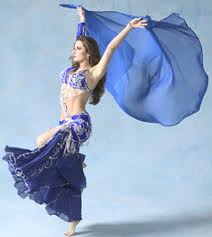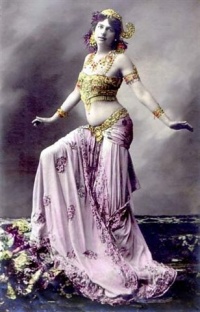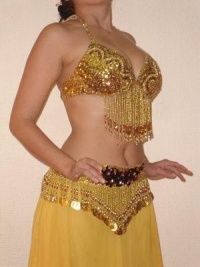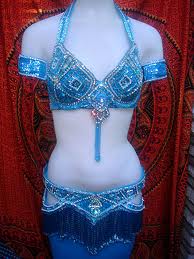Although the Arab nation was originally a group of nomadic tribes that occupied the territory of Arabia , with the emergence of Islam as a religion and its expansion throughout the world, a group of nations united by the same language and the same religion was formed, thus that what is now known as Arab dances is a multicultural artistic phenomenon. However, its roots lie in ancient Egypt . With the passage of time, various types of dances developed according to the theme expressed as well as their place of origin.

Origin
The dance arises in Egypt , in the year 1200/1300 BC, later with the appearance of Christianity it is prohibited for two reasons: first because it is considered pagan and second because the Woman Goddess was evoked here and Christianity established the male God , later figure who monopolized and created the patriarchal society. But the Copts (Christians from Egypt) perpetuated this dance that they performed in a hidden way.
Then this dance was performed by slave women who were in charge of popularizing it, the dance thus came out of the Temples and was part of the social entertainment of the time. Later in the early Middle Ages the arrival of Islamism again prohibited it until it disappeared. It reappears at the end of the 18th century in the small circles of slaves held in the palaces of the old medieval caliphates.
The slaves were the reflection of the power of the feudal lord, the beauty and skills of the dancers were valued (song / poetry / recitation). It is worth noting the cunning and intelligence of these women who exercised great influence on the caliphs.
Arab dance in Egypt
The custom of giving money to dancers also arises at this time, it was used to reward the talent of the artist with great respect by means of jewelry or coins, an activity that is still carried out today.
They shared the celebrations with magicians and snake charmers, their dances were accompanied by instruments called chinchines or zaggats that are bronze castanets, they also used to dance with the sword of a guest.
There were other types of dancers called “Gawazis or Egyptian gypsies”, they conserved the spiritual and aesthetic essence of this activity, the origin was Phoenician, Carthaginian, they loved to travel great distances and read the coffee and oysters, this dance also It had a popular reach and they shared the scene with minstrels, fortune-tellers and famous people of the medieval period.
The dress of this dancer has many ornaments, bracelets, pendants, coins, very cheerful bright colors. From the age of 40, it is about professionalizing dance, he joins ballet and at this time great musical pieces have been created. Today dance is already part of the great theaters.
Benefits

Arabic dance is highly therapeutic, since it not only confers benefits on the body by modeling it, but also makes sectors of the female body work where there are chakras or energy points neglected by other disciplines or forgotten by most women because of the leisure or stress.
With movement, hidden or repressed sensations appear, many women begin to reconcile with their body, to value themselves more from the feminine, to discover their sleeping sensuality and redirect their feelings and ideas about themselves.
In this way, you learn to channel energies, producing a release of tensions, and all this taking into account that by the nature of the exercises it is possible to model, turn, and sculpt the body without sacrifices, because these efforts are made in the form of a game.
To this are added to the choreographies, the positive contributions that according to music therapy provide the primitive sounds generated by ancient instruments such as the lute , the rebab , the Persian tar or the derbake , and the atmosphere of dream and legend that the Thousand and one night , and that relives in each chord of this millenary dance.
Arabic dance acts directly on the energy centers of the body, called ” chakras “, eliminating blockages, tensions and communication problems between these centers, harmonizing and letting these energies flow throughout the body in a mechanism in which we receive energies from the environment, we assimilate and return them renewed.
Results
Good humor, a feeling of well-being and agility, an attitude of dedication and generosity in human relationships, making its practitioners more sociable and active.
It produces unblocking of repressed emotions and tensions accumulated over time due to the difficult proposals of daily life, the concentration that must be directed towards the music and the movements of the choreographies makes it disengage from the problems, and then return to them with a more positive perspective .
It generates a process of self-knowledge that leads to an increase in self-esteem, understanding, acceptance and appreciation of one’s own body and being.
Celebrate life , fostering creativity and the expression of each individual’s personality.
Purification of the mind: stimulates memory, concentration, and the ability to respond physically to stimuli and orders given by the brain, allows better control over actions, movements, motor coordination and impulses.
Development of sensitivity, rhythm and reflexes. Each woman has seen that it is a dance that gives her special respect, discovering her strength, beauty and courage to affirm herself as the privileged being that she is, since the creator has shared with her the ability to give life.
Sacred dance

It is said that the Arab dance was a sacred dance because it arises in Egypt inside the Egyptian temples, of a ritual character performed by priestesses who had to lead a pure and orderly life in all planes. They danced and through their movements invoked divinity and then transmitted it, they were thus channels of divinity.
They also offered their dance to the gods to appease their anger. At first, they danced naked, since human nakedness was considered sacred in those times. The Egyptians used these dances at funerals and their “function” was to transport the soul of the deceased to the afterlife.
Cult of zaar
The zaar is a dance of Ethiopian origin closely related to a cult whose purpose is to cure the consequences caused by the possession of a spirit or group of spirits, called zarotsh, which could only be pacified through activities such as smoking, singing, moving the head and the body, wearing specific dresses, performing sacrifices, etc. It is a shamanic dance that is part of a ritual, which has, in turn, a choreographyperfectly defined. Like all manifestations of shamanic origin, this cult is not exclusive to a religion or a territory, but has occurred among Christians, Muslims, Jews, etc. In the Middle East it began to be mentioned around 1860, and researchers say that it occurred mainly among slave women of foreign origin. The leading dancer was known as Sheikhah; she and the other slaves accompanied each other with percussion and some melodies to carry out the rituals.
Belly Dancing
This dance combines traditional elements from the Middle East along with others from North Africa . It is a very elementary dance, practically without movement. It includes movements from ancient Egyptian folklore, but also from classical and contemporary dance, with great movements, turns and movements of all parts of the body, but especially the hip. Specialists have different theories about their place of origin. For some it comes from a religious dance that was practiced in the past by the priestesses of the Isis temples and Hathor was part of the traditional birth practices in the regions of origin. It had spread thanks to the migrations of gypsy peoples and similar groups of Hindu origin.
The best known theory is the one that associates belly dancing with a religious dance, but the other one that links it with “childbirth practices” is much more interesting anthropologically. Ramiro Guerra, Cuban choreographer and researcher of recognized international prestige, says in his book Appreciation of dance: “The torso, the basic center of the human body, along with the pelvis, are the original centers of movement production in primitive dance. While the poor action of the arms and legs is quite clear in the primitive style, on the contrary, the torso and pelvisthey have numerous centers of action capable of producing vital and energetic movements that shape their way of expression ”. Belly dance, as its name suggests, clearly belongs to the group of invocative dances of the fertility of the earth , animals and the human female.
Outside of the Middle East and North Africa, belly dancing became popular during the Romantic movement that occurred in Western Europe in the 18th and 19th centuries., and various orientalizing-style artists made them fashionable by dancing them at the Universal Fairs, as part of the exotic representations of harem life in the Ottoman Empire that they offered to visitors, with an excellent reception from the public, who he admired with genuine fury. Some silent film movies, such as “Fatima’s Dance”, show Arab dance sequences. The fact that common morality ended up disapproving of them is due, and not in a small part, to the fact that these dances had their most beautiful and famous interpreters in the most scandalously famous demi mondaines of the gay life of Paris , such as Mata Hari , la Bella Otero and the glittering Cleo de Mérode , the only one of the three who came from the ranks of classical ballet.
Mata Hari had no qualms about taking a holy dancer from the island of Java, and her dance style was closer to Indonesian dance than to the Middle East itself.
Description
Oriental folk dance has traditionally been improvised by a single dancer, although performances with choreography and several dancers can now be seen. It is characterized by its smooth and fluid movements, dissociating and coordinating the different parts of the body at the same time. For example, the arms can go at a different rate than the hip.
The focus is primarily on the hips and belly, alternating fast and slow movements and emphasizing the abdominal muscles, with chest and shoulder movements, as well as with meandering arms. The undulating, rotating movements, which are generally slow, symbolize sadness, whereas with the fast movements, blows and vibrations the dancer expresses joy.
All the movements of this dance are related to nature, for example, the soles of the feet rest well on the ground, a movement that symbolizes the earth, or also when the dancer extends her arms they always form a semi-U and are never fallen. , which symbolizes the birds.
In the beginning, the Arab dancers perfumed their wrists so that when they danced and when they moved their hands they perfumed themselves and their audience. At that time there were no perfumes, so they used oils.
Over the years, some traditional elements have been included to “adorn” this type of dance, such as: veils, saber , cane , candles , rattles , wings of Isis (and candelabra of many candles held aloft on the heads of the dancers, which seem to come from ancient Egyptian rituals celebrated by the priestesses in the temples dedicated to Isis, goddess of fertility for the inhabitants of the Nile and Egyptian representation of the Paleolithic Mother Goddess who ruled in the matriarchy.
Although this dance is usually female, there are also some male dancers. For each element there is a rhythm, and for each song a technique, although many modern artists.
Locker room

The attire with which this dance is usually associated is called bedlah in Arabic, which means “uniform”, and comes from the one worn by dancers in Egypt in the 1930s. Its creation is due to the vaudeville with its fanciful representations of the harem of the Great Turk, and Hollywood at the beginning of the last century, but by no means the true traditional costume of the Middle East. It consists mainly of a fitted bra (usually adorned with beads or coins), a belt fitted at the hip (also decorated with coins or beads), and harem pants and / or skirts, which can be plain, layered, etc. The use of other elements such as the veil has also spread to frame movements.
Egyptian dancers usually use it only at the beginning of the dance, while in the West it can be used throughout the performance. In reality, and although it is much less glamorous to the eye, ancient Egyptian dancers wore a kind of sash around the waist, a very simple linen or cotton skirt, and bare breasts. As the main decoration, images of the goddess of sexuality were tattooed on the thighs and arms.
